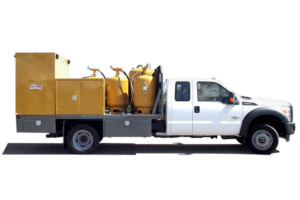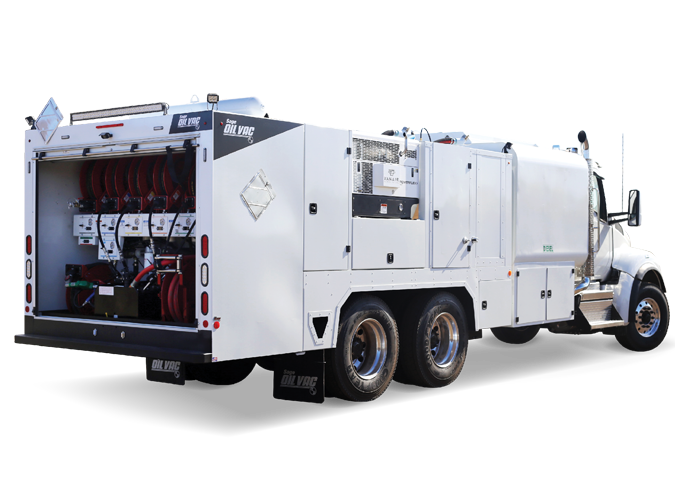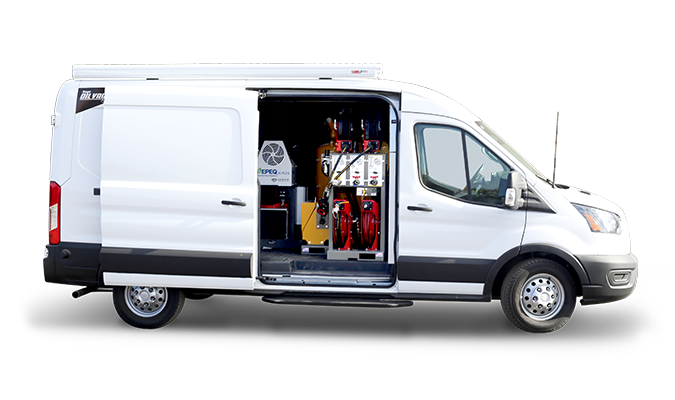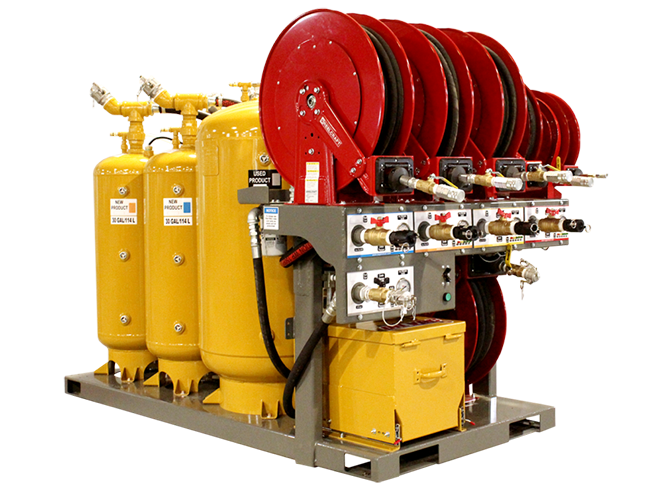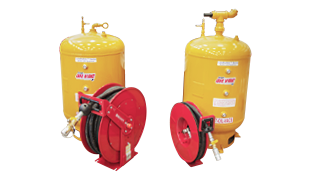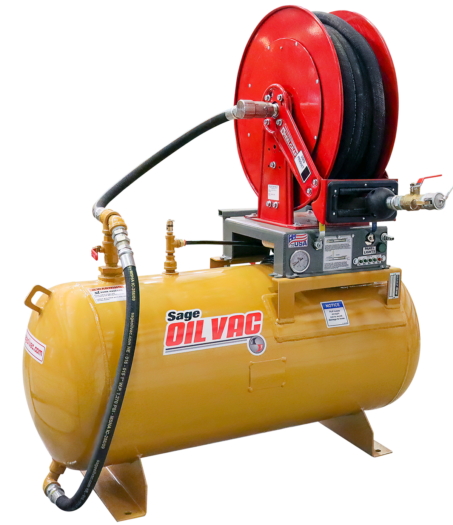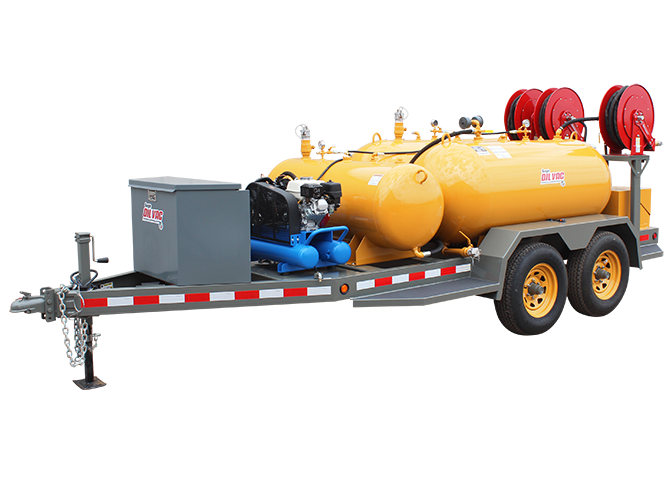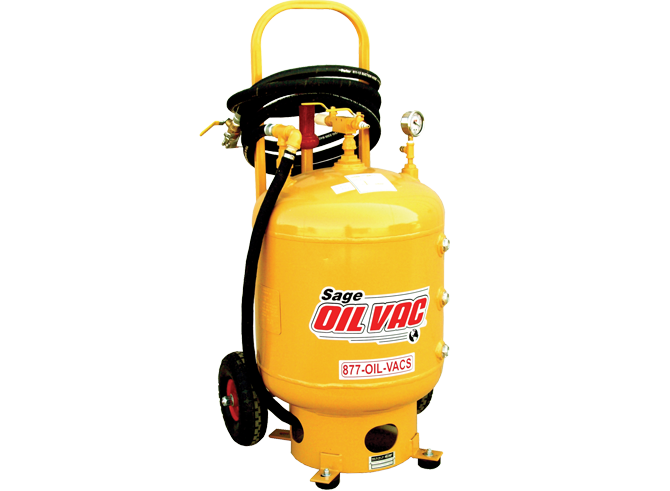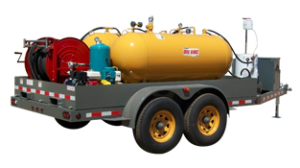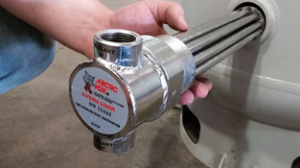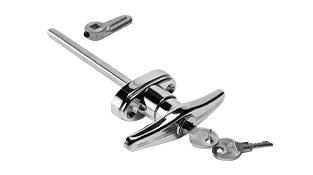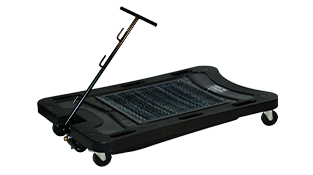If plummeting temperatures stress you out, just imagine what they do to your equipment and field service technicians. While changing oil in cold weather is necessary, it can take a toll on both people and machines. Working in subzero conditions quickly induces fatigue. And as the mercury drops, oil thickens and equipment becomes more reluctant to turn over due to the increased oil friction resistance and decreased battery efficiency.
However, delaying preventive maintenance is not a successful strategy. Don’t wait for freezing temperatures to catch you out in the cold. Be prepared with the right procedures, fluids and equipment to keep your machines and technicians productive. We’ve broken down our top tips for changing oil in cold weather.
Keep the oil flowing
Oil viscosity is the key differentiator in cold-weather operations. It measures the resistance of the oil to flow at different temperatures — ultimately determining the thickness or thinness of the oil. This is perhaps one of the most important properties of oil because viscosity provides the lubrication film between metal parts. The viscosity needs to be thick enough to prevent metal contact while being thin enough to prevent excessive energy loss.
Temperature changes can influence oil viscosity, which makes changing oil in cold weather more difficult. You’ll need the right oil to match the conditions. The oil must remain sufficiently viscous at high temperatures, but it can’t be too thick at low temperatures. The oil must remain robust across a wide temperature range to handle cold starts in the winter and normal internal operating temperatures.
When selecting the appropriate oil, pay particular attention to the number before the W in the oil specification. That number stands for the winter viscosity. A lower number means it is more fluid at a colder temperature. For instance, a 5W-40 engine oil is thinner in cold temperatures than a 10W-30.
Since viscosity is dependent on temperature, consult the equipment owner’s manual and make sure you are using the recommended oil for the temperatures you will be operating in. Equipment operator manuals may suggest different oils for varying temperature ranges.
Changing oil in cold weather
Never perform ‘cold’ oil changes, regardless of the weather outside. Best practice dictates oil should always be warm so it flows freely and drains completely. Start the engine to circulate the oil prior to the oil change or perform the oil change shortly after the equipment has been shut down for the day.
Running the engine immediately prior to an oil change also helps ensure better removal of contaminants from inside the engine. When the machine is working, contaminants from wear, the combustion process and the environment are suspended in the oil.
Shortly after shutting the machine down, these contaminants settle out to internal surfaces and the bottom of the oil pan. If you change the oil after the engine has been at rest, these contaminants will likely adhere to the internal engine surfaces.
Get a leg up on the competition
Why not just bring the equipment to a heated shop where technicians can work in comfort? While this sounds like a logical solution for changing oil in cold weather, there are several drawbacks to consider. When equipment is integral to a jobsite’s overall operation, the time and cost to transport equipment to the shop and back results in lost productivity. This can quickly erode revenue potential.
It is often simply more cost-effective to service equipment on the jobsite, even during the cold weather months. Sage Oil Vac can help you find solutions that will give you a leg up on the competition while protecting vital assets — your technicians and your equipment.
Make it easier for technicians
Working long hours to finish changing oil in cold weather can be unbearable with a subpar lube truck setup. Using buckets to change the oil further complicates the task and exposes technicians to hot oil. Having the right tools for the job makes all the difference.
Using a closed-loop system with quick disconnects protects your technicians from oil exposure and reduces manual effort while your technicians battle the weather. Less physical effort in subzero temperatures means more productive technicians.
The Sage Oil Vac system reduces the effort required by your technicians. It uses compressed air to build air pressure and move fluids to and from tanks. Hot motor oil can be vacuumed from equipment at up to six to eight gallons per minute. This enclosed, no-pump system with sealed tanks protects both the operator and the environment from spills.
Options for enclosed trailers, enclosed trucks or even a custom system can also simplify changing oil in cold weather. Sage Oil Vac offers heated fluid tanks that use immersion heaters to help promote productivity. Coolant circulates through probes in the tank, transferring heat to the oil and enabling easier oil changes as outside temperatures plummet.
Sage Oil Vac also offers an optional heated grease probe. This allows the technician to heat grease and improve flow rates in cold weather months.
Make it easier for your technicians. Contact Sage Oil Vac and get prepared for any weather.
Finding drivers and navigating tight urban jobsites requires an innovative approach.
BY AARON SAGE
The long-standing driver shortage continues to worsen while many contractors also face ever more crowded urban jobsites. These challenges place a squeeze on existing mobile lube activities.
Large Class 7 or Class 8 lube/fuel trucks have been the norm on jobsites around the U.S. for decades. These trucks help technicians maximize preventive maintenance efficiency by transporting large quantities of off-road diesel and oil. Technicians can service multiple machines in the field before returning to the shop for additional fluids.
The capacity of these trucks depends on the Gross Vehicle Weight Rating (GVWR), which defines the maximum legal weight of a vehicle including passengers and cargo. The GVWR helps determine how many gallons of fluid a lube truck can transport. It’s not uncommon for Class 7 or Class 8 lube/fuel trucks to haul up to 1,000 gallons of fuel and 400 gallons of maintenance fluids in one trip.
While the capacity provides a clear advantage for some applications, Class 7 and larger trucks exceeding 26,000 pounds GVWR requires operators with commercial driver’s license (CDL). With these drivers becoming harder to find, some lube truck owners are exploring smaller trucks that don’t require a CDL — those in Class 5 and Class 6 — to help them care for equipment on the job. In the process, they’re discovering the cost and efficiency benefits of deploying these smaller open- and enclosed non-CDL trucks that weren’t frequently seen on jobsites just a few years ago.
Cope with the driver shortage
The first factor driving the transition to non-CDL trucks is the worsening driver shortage. Despite growing demand for all types of commercial transportation that requires a CDL — namely over-the-road trucking — the number of licensed commercial drivers in the U.S. has not increased. In short, the demand is growing but the qualified labor pool is not. There’s just a shortage of qualified, skilled drivers. It’s as simple as that.
This places lube truck owners in direct competition with over-the-road haulers and local businesses. You can invest over a month sending your employee to a driver school to earn a CDL, but there is no guarantee that you can retain that driver to recoup the investment.
Sprint Sand and Clay specializes in dirt work and selling construction materials to contractors and home builders in Greater Houston, Texas. When it comes to operating lube trucks for preventive maintenance, they find drivers with a CDL can demand higher compensation. It is also difficult to compete for available drivers because many don’t want to service equipment. They simply want to drive.
“Trying to find a CDL driver that wants to perform the service, not just take a load from point A to point B all day, is tough,” said Jacob Phillips, vice president of operations at Sprint Sand and Clay.
Lube truck owners can proactively address this challenge by eliminating the licensing requirement and creating new opportunities for existing employees. Without the requirement for special licensing, almost any technician in the shop can be assigned to run a non-CDL truck. This opens the door to more hiring opportunities for company owners and managers and more employment opportunities for operators.
Balance capacity and efficiency
The second factor in the transition to non-CDL trucks is the actual fluid capacity needed to service equipment. Contractors simply may not need the capacity or fuel-handling capability of a Class 7 or Class 8 lube truck. While not having enough capacity to service all the equipment on the jobsite leads to a loss of efficiency, hauling excess capacity decreases efficiency as well.
Sprint Sand and Clay knew they needed a solution that would balance capacity with efficiency. When the maintenance staff must service more than 200 pieces of heavy equipment on 35 jobsites across the fourth largest U.S. city, efficiency is essential. That’s the challenge this contractor faces each day. When its lube truck leaves the shop, it may travel two hours one way to a jobsite.
“It’s important that the truck has enough storage and fluid capacity to service many pieces of equipment on that side of town before going back and refilling the truck,” said Kyle Cain, president of Sprint Sand and Clay.
Sprint Sand and Clay’s service technician typically performs preventive maintenance on every piece of equipment while the truck is on a jobsite to maximize efficiency.
“In today’s world, you have to be as efficient as possible. We attribute our success a lot to equipment that we use and the innovation that’s provided with that equipment, from our dump trucks to our equipment to our lube trucks,” said Cain.
Sprint Sand and Clay turned to a Sage Oil Vac non-CDL open lube body. The non-CDL bodies — available in both open and enclosed formats — are perfect for heavy equipment preventive maintenance. The open non-CDL lube body features a 180-gallon (681.37-L) used oil tank and five fresh product tanks with a combined 400-gallon (1,514-L) capacity. The enclosed lube body offers additional protection from the elements and higher fluid capacity — with a 220-gallon (832.8-L) used oil tank, 420 gallons of new oil capacity, 120-pound grease capacity, and 60-gallon tanks for new and used coolant.
“We really believe in the small compact size of a Sage lube truck. It’s very efficient and the cost of ownership compared to having a larger CDL truck with a CDL driver just makes sense,” said Cain.
Despite its compact size, the non-CDL open lube body is up to the task of servicing Sprint Sand and Clay’s 200-machine fleet. It offers the capacity to service all the equipment on up to two jobsites without having to go back to the shop to fill up.
Minimize operating costs
The third factor in the transition to a non-CDL lube truck is the lower operating cost. It is easy to assume a bigger lube truck would drive efficiency, but that’s not always the case. Traditional Class 7 or Class 8 trucks have high fluid capacities, enabling them to service a lot of equipment. However, due to their size, they’re also less fuel efficient when traveling long distances.
If the smaller truck has the capacity to tackle a day’s worth of preventive maintenance without returning to the shop, it may provide a lower cost of operation. For instance, smaller displacement engines consume less fuel when driving long distances between jobsites.
Without wasted extra capacity, utilization costs can decrease. Lower upfront costs paired with a smaller operating cost translate into a higher return on investment. Maintenance staff can calculate the total weight of the products that need to be carried to help assess truck size. It’s not always beneficial to automatically size up the next truck.
There are also regulatory costs to consider when operating larger trucks — which become an even bigger issue when traveling across state lines. Multiple non-CDL trucks will sometimes be more cost-effective and efficient than one Class 8 truck. It’s sometimes hard to get people to make a change like that, but when you put pencil to paper, these changes can pay for themselves in months.
Access tight jobsites
A fourth factor to consider in the transition to a non-CDL lube truck would be jobsite access. Larger tandem-axle trucks can be difficult to maneuver on jobsites with uneven terrain. A single-axle non-CDL service truck offers enhanced maneuverability on tight or crowded jobsites. These lighter-weight trucks can also perform better than larger tandem-axle trucks in rough terrain. Sage Oil Vac uses Chevrolet 6500, Ford F-600 and International 6500 four-wheel drive chassis. This adds mobility seldom seen with a larger truck due to the driven steer axle.
If you’re working at a remote location that has a lot of challenging terrain, the smaller jobsite lube truck is going to be nimbler and will perform better in terrain like that than a larger, tandem-axle truck. This added maneuverability has been beneficial to Sprint Sand and Clay.
“It’s been very easy to maneuver in traffic, especially in Houston,” noted Cain.
Maneuverability coupled with quick connect fillings and design of the Sage Oil Vac system with its sealed tanks reduces the chance of oil spills.
“A lot of our jobs are on government entity property — cities and counties — so being able to get in and out without having any spillage or environmental issues is very important to us,” said Cain.
Consider all alternatives
There are several reasons for transitioning to a non-CDL lube truck. It opens the available labor force, it can reduce operating costs, it is more maneuverable and there is a lower acquisition cost. The latter was particularly important for Sprint Sand and Clay.
The compact size and efficient operation of the non-CDL truck gives Sprint Sand and Clay a cost-effective heavy equipment service option. It provided a more cost-effective solution than relying on the local equipment dealer for preventive maintenance.
“I think when you compare what we would have to pay from the dealership versus doing it ourselves, it just really made sense for us,” said Cain.
But the non-CDL truck is not the best answer for every application. You really need to look at all available options and determine if a larger lube/fuel truck, a trailer or a jobsite skid will work best in your specific application. Each solution has its own unique set of benefits.
* This article was first published in the July issue of Equipment Today magazine.

